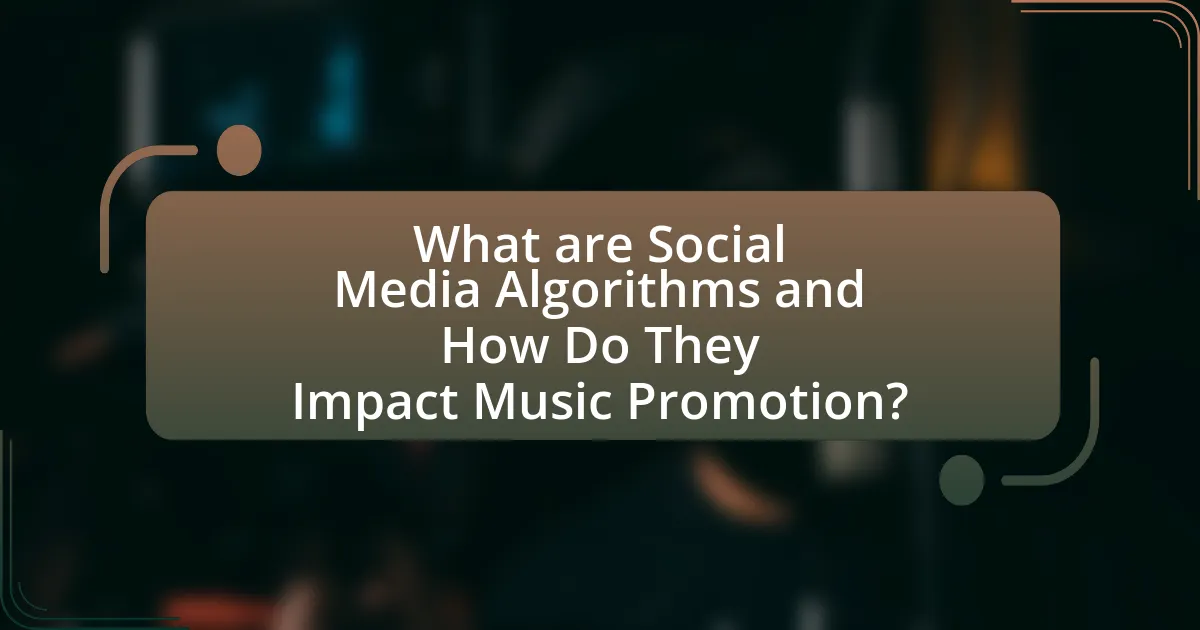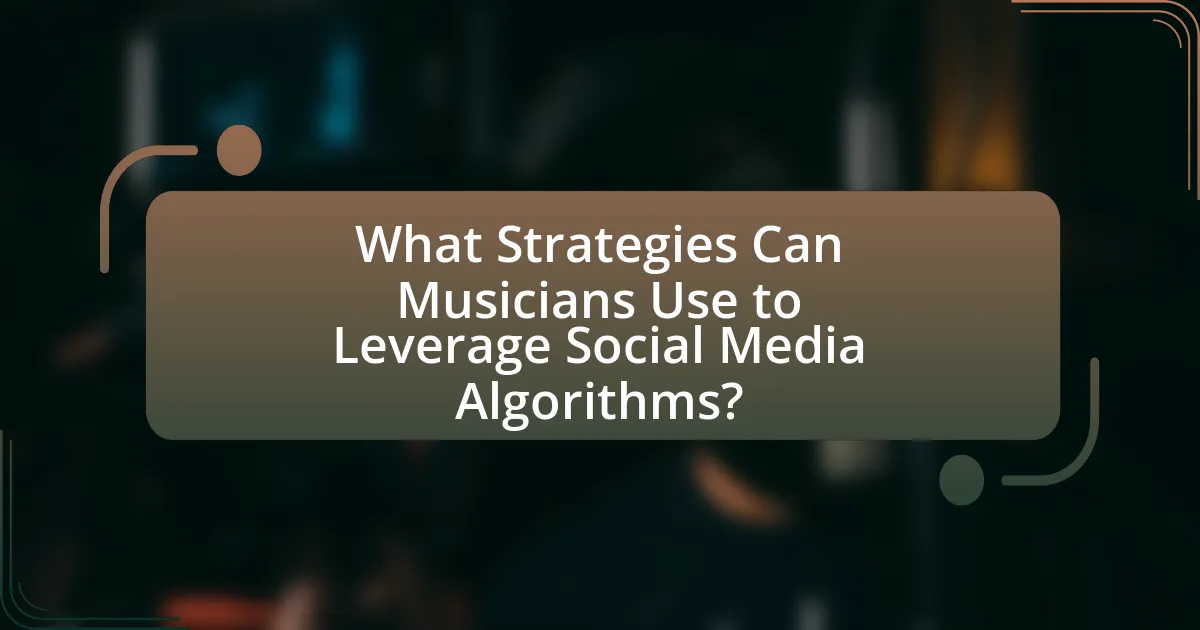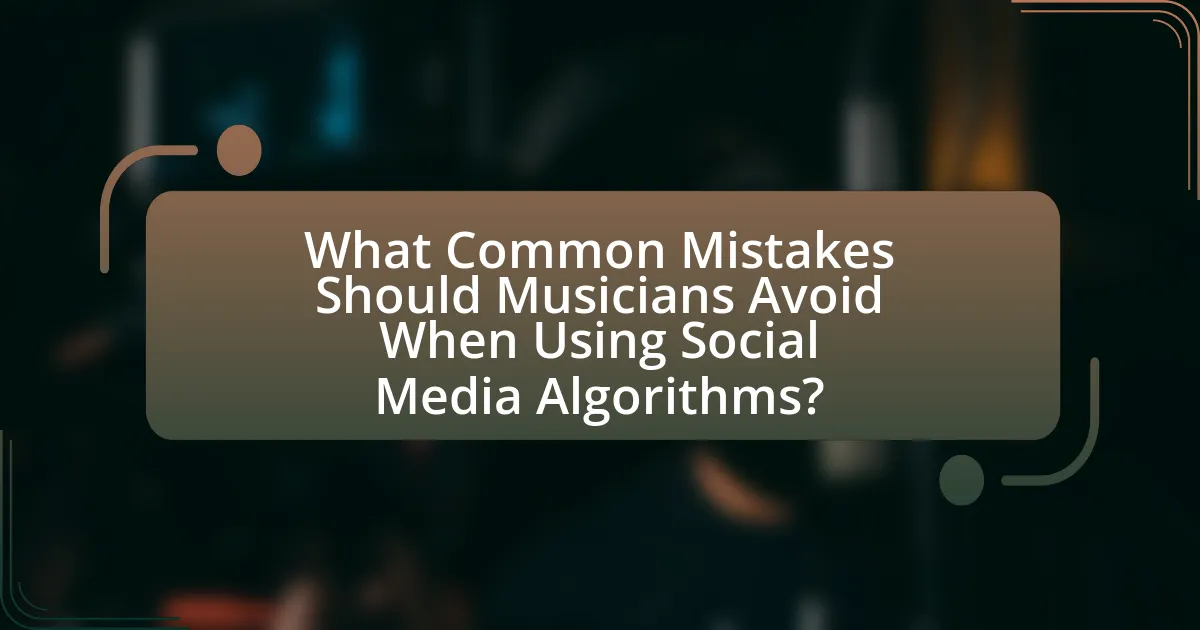Social media algorithms are mathematical formulas that determine content visibility based on user behavior and preferences, playing a crucial role in music promotion. This article explores how these algorithms function, the factors influencing their effectiveness, and the importance of user engagement metrics. It outlines strategies musicians can employ to leverage algorithms for increased visibility, including consistent posting, engaging content creation, and audience interaction. Additionally, it highlights common mistakes to avoid and best practices for optimizing promotional efforts on various platforms, ultimately providing insights into measuring success and adapting to algorithm changes.

What are Social Media Algorithms and How Do They Impact Music Promotion?
Social media algorithms are complex mathematical formulas used by platforms to determine which content is shown to users based on their behavior and preferences. These algorithms significantly impact music promotion by prioritizing posts that engage users, such as likes, shares, and comments, thereby increasing visibility for artists and their music. For instance, platforms like Instagram and TikTok utilize engagement metrics to surface content, meaning that music-related posts that resonate with audiences are more likely to be seen by a larger number of users. This creates opportunities for artists to reach potential fans and promote their music effectively, as evidenced by the rise of viral music trends on TikTok, where songs gain popularity through user-generated content.
How do social media algorithms function in the context of music promotion?
Social media algorithms function in music promotion by analyzing user engagement data to determine which content is most relevant to individual users. These algorithms prioritize posts that receive high levels of interaction, such as likes, shares, and comments, thereby increasing the visibility of music-related content that resonates with audiences. For instance, platforms like Instagram and TikTok utilize machine learning to tailor users’ feeds based on their previous interactions, ensuring that popular songs or emerging artists gain traction among targeted demographics. This targeted approach is supported by statistics indicating that posts with higher engagement rates are more likely to appear in users’ feeds, thus amplifying the reach of music promotions.
What factors influence the effectiveness of social media algorithms for music promotion?
The effectiveness of social media algorithms for music promotion is influenced by user engagement metrics, content relevance, and algorithmic transparency. User engagement metrics, such as likes, shares, and comments, directly impact how algorithms prioritize content, with higher engagement leading to increased visibility. Content relevance is crucial, as algorithms analyze user preferences and behaviors to serve tailored music recommendations, enhancing the likelihood of user interaction. Algorithmic transparency, or the clarity with which platforms communicate how their algorithms function, can also affect artists’ strategies in promoting their music, as understanding these mechanisms allows for more effective content creation. These factors collectively shape the reach and impact of music promotion efforts on social media platforms.
How do user engagement metrics affect algorithm performance?
User engagement metrics significantly influence algorithm performance by determining how content is prioritized and displayed to users. High engagement metrics, such as likes, shares, comments, and watch time, signal to algorithms that content is valuable and relevant, leading to increased visibility and reach. For instance, platforms like Facebook and Instagram utilize engagement data to refine their algorithms, ensuring that posts with higher interaction rates are shown more prominently in users’ feeds. Research indicates that content with higher engagement rates can achieve up to 50% more visibility compared to less engaging content, demonstrating the direct correlation between user interaction and algorithmic success.
Why is understanding social media algorithms crucial for musicians and promoters?
Understanding social media algorithms is crucial for musicians and promoters because these algorithms determine the visibility and reach of their content. By grasping how algorithms prioritize posts based on engagement, relevance, and user behavior, musicians can tailor their strategies to enhance audience interaction. For instance, platforms like Instagram and TikTok utilize engagement metrics such as likes, shares, and comments to rank content, meaning that musicians who create engaging posts are more likely to be seen by a larger audience. Additionally, research indicates that posts optimized for algorithmic preferences can lead to a significant increase in follower growth and engagement rates, which are essential for successful music promotion.
What advantages do musicians gain by leveraging algorithms?
Musicians gain increased visibility and audience engagement by leveraging algorithms. Social media platforms utilize algorithms to curate content, ensuring that music-related posts reach targeted demographics based on user preferences and behaviors. For instance, platforms like Spotify and Instagram analyze user data to recommend music and promote posts, which can lead to higher streaming numbers and follower growth. This targeted exposure can significantly enhance a musician’s ability to connect with potential fans, ultimately driving sales and concert attendance.
How can a lack of understanding hinder music promotion efforts?
A lack of understanding can significantly hinder music promotion efforts by preventing artists and promoters from effectively utilizing social media algorithms. Without knowledge of how these algorithms prioritize content, music promotion strategies may fail to reach target audiences, resulting in lower engagement and visibility. For instance, research indicates that posts optimized for engagement, such as those with compelling visuals or interactive elements, are favored by platforms like Instagram and Facebook, leading to increased reach. Therefore, without grasping these dynamics, promotional efforts may miss opportunities to connect with listeners, ultimately limiting an artist’s growth and success in a competitive market.

What Strategies Can Musicians Use to Leverage Social Media Algorithms?
Musicians can leverage social media algorithms by consistently posting engaging content, utilizing trending hashtags, and interacting with their audience. Consistent posting increases visibility, as algorithms favor active accounts; for instance, Instagram’s algorithm prioritizes recent content. Using trending hashtags can enhance discoverability, as posts with popular tags often reach wider audiences. Engaging with followers through comments and direct messages fosters community, which algorithms reward by boosting post visibility. Additionally, collaborating with other artists can expose musicians to new audiences, further enhancing algorithmic favor.
How can content creation be optimized for social media algorithms?
Content creation can be optimized for social media algorithms by focusing on engagement, relevance, and consistency. Engaging content, such as videos and interactive posts, tends to receive higher visibility due to algorithms prioritizing user interaction. For instance, platforms like Instagram and TikTok reward content that generates likes, comments, and shares, leading to increased reach.
Relevance is crucial; using trending topics and hashtags can align content with current user interests, enhancing discoverability. Research indicates that posts utilizing popular hashtags can increase engagement by up to 30%. Consistency in posting schedules also plays a significant role, as algorithms favor accounts that regularly update their content, fostering audience retention and growth.
By combining these strategies—creating engaging, relevant content and maintaining a consistent posting schedule—content creators can effectively optimize their output for social media algorithms, thereby enhancing their visibility and impact in music promotion.
What types of content resonate best with audiences on different platforms?
Visual content, particularly videos and images, resonates best with audiences on platforms like Instagram and TikTok, while informative articles and blog posts perform well on Facebook and LinkedIn. For instance, TikTok’s algorithm favors short, engaging videos that capture attention quickly, leading to higher engagement rates. In contrast, LinkedIn users prefer long-form content that provides professional insights, as evidenced by a study showing that posts with 1,900 words receive the most engagement. Additionally, Twitter thrives on concise text updates and trending topics, with tweets that include images or videos generating 150% more retweets. These platform-specific preferences highlight the importance of tailoring content to maximize audience engagement.
How often should musicians post to maximize algorithmic visibility?
Musicians should post at least three to five times per week to maximize algorithmic visibility on social media platforms. This frequency helps maintain engagement and keeps the content fresh, which is favored by algorithms. Research indicates that platforms like Instagram and Facebook prioritize accounts that post regularly, as consistent activity signals relevance and engagement to the algorithm. For instance, a study by Hootsuite found that brands that post 3-5 times a week see higher engagement rates compared to those that post less frequently.
What role does audience engagement play in algorithmic success?
Audience engagement is crucial for algorithmic success as it directly influences how content is prioritized and distributed by social media platforms. High levels of engagement, such as likes, shares, comments, and watch time, signal to algorithms that the content is valuable and relevant, leading to increased visibility and reach. For instance, platforms like Instagram and TikTok utilize engagement metrics to determine which posts appear on users’ feeds, favoring content that generates interaction. Research indicates that posts with higher engagement rates can achieve up to 10 times more visibility than those with lower interaction, demonstrating the significant impact of audience engagement on algorithmic performance.
How can musicians encourage more interaction with their posts?
Musicians can encourage more interaction with their posts by creating engaging content that prompts audience participation. This includes asking questions, hosting polls, and encouraging comments by sharing personal stories or behind-the-scenes insights. Research indicates that posts with questions receive 100% more comments than those without, highlighting the effectiveness of interactive content. Additionally, utilizing visually appealing images or videos can capture attention and increase engagement rates, as posts with visuals are known to receive 94% more views. By consistently applying these strategies, musicians can significantly enhance interaction with their social media posts.
What are effective ways to respond to audience feedback and comments?
Effective ways to respond to audience feedback and comments include acknowledging the feedback, providing thoughtful responses, and engaging in dialogue. Acknowledging feedback shows that the audience’s opinions are valued, which can enhance community trust and loyalty. Providing thoughtful responses, rather than generic replies, demonstrates genuine interest and understanding of the audience’s concerns or suggestions. Engaging in dialogue encourages further interaction, fostering a sense of community and connection. Research indicates that brands that actively engage with their audience can see a 20-40% increase in customer satisfaction and loyalty, highlighting the importance of effective communication in social media contexts.

What Common Mistakes Should Musicians Avoid When Using Social Media Algorithms?
Musicians should avoid inconsistencies in posting schedules when using social media algorithms. Regular and predictable posting enhances engagement and visibility, as algorithms favor active accounts. Additionally, musicians must not ignore audience interaction; failing to respond to comments and messages can lead to decreased algorithmic favor, as engagement signals are crucial for visibility. Another mistake is neglecting analytics; without analyzing performance metrics, musicians miss opportunities to refine their strategies based on what content resonates with their audience. Lastly, musicians should avoid using overly promotional content; algorithms often prioritize authentic engagement over sales pitches, so sharing personal stories or behind-the-scenes content can foster a stronger connection with followers.
What pitfalls can negatively impact algorithm performance?
Pitfalls that can negatively impact algorithm performance include data quality issues, overfitting, and lack of diversity in training data. Data quality issues arise when the input data is noisy, incomplete, or biased, leading to inaccurate predictions. Overfitting occurs when an algorithm learns the training data too well, capturing noise instead of the underlying pattern, which reduces its ability to generalize to new data. Additionally, a lack of diversity in training data can result in algorithms that perform poorly across different demographics or contexts, as they may not be exposed to a wide range of scenarios during training. These factors collectively hinder the effectiveness of algorithms in promoting music on social media platforms.
How can over-promotion harm a musician’s visibility on social media?
Over-promotion can harm a musician’s visibility on social media by leading to audience fatigue and decreased engagement. When musicians excessively promote their content, followers may become overwhelmed and disengage, resulting in lower interaction rates. Research indicates that social media algorithms prioritize content that generates engagement; thus, if a musician’s posts receive less interaction due to over-promotion, the algorithm may reduce the visibility of their future posts. For instance, a study by Buffer found that posts with high promotional content saw a 50% drop in engagement compared to more balanced content. This decline in engagement can create a cycle where the musician’s visibility continues to diminish, ultimately affecting their reach and growth on social media platforms.
What are the risks of ignoring platform-specific best practices?
Ignoring platform-specific best practices can lead to reduced visibility and engagement on social media platforms. When best practices are overlooked, content may not be optimized for the algorithms that govern user interactions, resulting in lower reach and fewer impressions. For instance, a study by Hootsuite found that posts adhering to platform guidelines receive up to 50% more engagement compared to those that do not. Additionally, failure to follow these practices can damage brand reputation, as audiences may perceive the content as unprofessional or irrelevant. This can ultimately hinder the effectiveness of music promotion efforts, as artists and labels rely on social media to connect with fans and grow their audience.
How can musicians measure the effectiveness of their algorithm strategies?
Musicians can measure the effectiveness of their algorithm strategies by analyzing engagement metrics such as likes, shares, comments, and follower growth on social media platforms. These metrics provide quantitative data that reflects how well their content resonates with audiences, indicating the success of their algorithm-driven promotional efforts. For instance, a study by the Pew Research Center found that 69% of adults in the U.S. use social media, highlighting its significance in reaching potential listeners. By tracking changes in these metrics before and after implementing specific algorithm strategies, musicians can assess the impact of their promotional tactics on audience engagement and overall reach.
What metrics should be tracked to assess success in music promotion?
To assess success in music promotion, key metrics include engagement rates, reach, conversion rates, and audience growth. Engagement rates, which encompass likes, shares, and comments, indicate how well the audience interacts with the content. Reach measures the total number of unique users who see the promotional material, providing insight into visibility. Conversion rates track the percentage of users who take a desired action, such as streaming a song or purchasing tickets, reflecting the effectiveness of the promotion. Audience growth quantifies the increase in followers or subscribers over time, showcasing the campaign’s ability to attract new listeners. Collectively, these metrics provide a comprehensive view of the promotion’s impact and effectiveness.
How can data analytics tools assist in refining promotional strategies?
Data analytics tools assist in refining promotional strategies by providing insights into consumer behavior and campaign performance. These tools analyze data from various sources, such as social media interactions, website traffic, and sales figures, enabling marketers to identify trends and preferences among their target audience. For instance, a study by McKinsey & Company found that companies using data analytics for marketing can improve their ROI by 15-20%. By leveraging these insights, businesses can tailor their promotional content, optimize ad placements, and enhance targeting, ultimately leading to more effective marketing campaigns.
What are the best practices for leveraging social media algorithms in music promotion?
To effectively leverage social media algorithms in music promotion, artists should focus on creating engaging content that encourages interaction. Engaging content, such as behind-the-scenes videos, live performances, and interactive polls, increases user engagement, which is favored by algorithms. For instance, platforms like Instagram and TikTok prioritize posts that generate likes, comments, and shares, leading to greater visibility.
Additionally, artists should post consistently and at optimal times when their audience is most active, as this can enhance reach and engagement. Research indicates that posting during peak hours can increase engagement rates by up to 30%. Utilizing hashtags strategically can also improve discoverability, as posts with relevant hashtags can reach a broader audience beyond existing followers.
Collaborating with influencers or other artists can further amplify reach, as their established audiences can be introduced to new music. Data shows that influencer partnerships can increase engagement rates by 11 times compared to traditional advertising.
Finally, analyzing performance metrics through social media insights allows artists to refine their strategies based on what content resonates most with their audience, ensuring ongoing optimization of their promotional efforts.
How can musicians create a balanced content strategy that aligns with algorithms?
Musicians can create a balanced content strategy that aligns with algorithms by consistently producing high-quality, engaging content while also adhering to platform-specific best practices. This involves understanding the algorithms of platforms like Instagram, TikTok, and YouTube, which prioritize content that generates interaction, such as likes, shares, and comments. For instance, musicians should post regularly, utilize trending hashtags, and engage with their audience through comments and live sessions to boost visibility. Research indicates that posts with a higher engagement rate are favored by algorithms, leading to increased reach and exposure. Therefore, a strategic mix of promotional content, behind-the-scenes glimpses, and interactive posts can effectively align with algorithmic preferences while maintaining audience interest.
What tips can help musicians stay updated on algorithm changes and trends?
Musicians can stay updated on algorithm changes and trends by actively following industry news, engaging with social media platforms, and participating in relevant online communities. Regularly checking resources like music industry blogs, social media updates, and algorithm change announcements from platforms such as Spotify and Instagram provides essential insights. Additionally, joining forums or groups focused on music promotion allows musicians to share experiences and strategies, enhancing their understanding of current trends. According to a 2022 report by the International Federation of the Phonographic Industry, 70% of music professionals rely on social media analytics to adapt their promotional strategies, highlighting the importance of staying informed.
